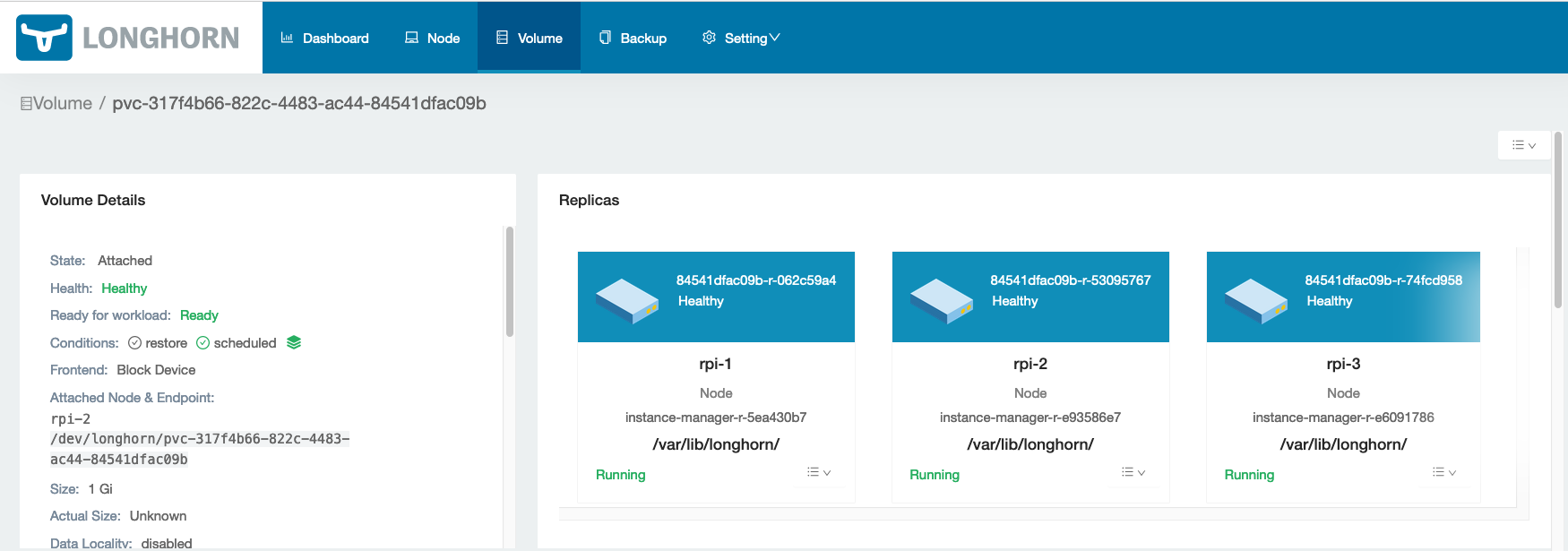K3s on Raspberry Pi - Volumes and Storage
In this post we’ll look at how volumes and storage work in a K3s cluster.
Local Path Provisioner
K3s comes with a default Local Path Provisioner that allows creating a PersistentVolumeClaim backed by host-based storage. This means the volume is using storage on the host where the pod is located.
Let’s take a look at an example…
Create a specification for a PersistentVolumeClaim and use the storageClassName of local-path:
apiVersion: v1
kind: PersistentVolumeClaim
metadata:
name: local-path-pvc
namespace: default
spec:
accessModes:
- ReadWriteOnce
storageClassName: local-path
resources:
requests:
storage: 1Gi
Create a specification for a Pod that binds to this PVC:
apiVersion: v1
kind: Pod
metadata:
name: local-path-test
namespace: default
spec:
containers:
- name: local-path-test
image: nginx:stable-alpine
imagePullPolicy: IfNotPresent
volumeMounts:
- name: local-path-pvc
mountPath: /data
ports:
- containerPort: 80
volumes:
- name: local-path-pvc
persistentVolumeClaim:
claimName: local-path-pvc
Create these two resources with kubectl:
kubectl create -f pvc-local-path.yaml
kubectl create -f pod-local-path-test.yaml
After a minute or so, we should be able to see our running pod:
kubectl get pods -o wide
NAME READY STATUS RESTARTS AGE IP NODE
local-path-test 1/1 Running 0 7m7s 10.42.2.34 rpi-2
The pod only has one container, so we can get a shell to the container with the following command:
kubectl exec -it local-path-test -- sh
/ #
Create a test file in /data, which is the mountPath for the persistent volume:
/ # echo "testing" > /data/test.txt
/ # ls -l /data/
total 4
-rw-r--r-- 1 root root 8 May 15 20:24 test.txt
The output above showed that this pod is running on the node rpi-2.
If we exit out of the shell for the container, and then SSH to the node rpi-2, we can expect to the find the file test.txt somewhere, since the persistent volume is backed by host-based storage.
ssh pi@rpi-2
sudo find / -name test.txt
/var/lib/rancher/k3s/storage/pvc-a5a439ab-ea94-481d-bee2-9e5c0e0f8008_default_local-path-pvc/test.txt
This shows that we get out-of-the-box support for persistent storage with K3s, but what if our pod goes down and is relaunched on a different node?
In that case, the new node won’t have access to the data from /var/lib/rancher/k3s/storage on the previous node. To handle that case, we need distributed block storage.
With distributed block storage, the storage is decouple from the pods, and the PersistentVolumeClaim can be mounted to the pod regardless of where the pod is running.
Longhorn
Longhorn is a “lightweight, reliable and easy-to-use distributed block storage system for Kubernetes.” It is also created by Rancher Labs, so it makes the integration with K3s very easy.
For the most part, we can just follow the Longhorn Install Documentation.
First, make sure you install the open-iscsi package on all nodes:
sudo apt-get install open-iscsi
On my first attempt, I forgot to install this package and ran into issues later.
Deploy Longhorn using kubectl:
kubectl apply -f https://raw.githubusercontent.com/longhorn/longhorn/v0.8.0/deploy/longhorn.yaml
We can see everything created by listing all resources in the longhorn-system namespace:
kubectl get all --namespace longhorn-system
There are too many resources to list here, but wait until everything is running.
Longhorn has an admin UI that we can access by creating an ingress:
apiVersion: networking.k8s.io/v1
kind: Ingress
metadata:
namespace: longhorn-system
name: longhorn-ingress
annotations:
kubernetes.io/ingress.class: "traefik"
spec:
rules:
- host: longhorn-ui
http:
paths:
- path: /
pathType: Prefix
backend:
service:
name: longhorn-frontend
port:
number: 80
Originally I wanted to remove the host entry to let it bind to all hosts, and specify a more specific path, but currently there is an issue where the path must be /.
So we can leave the host and path as shown, and work around this by creating an /etc/hosts entry on our local machine to map the hostname of longhorn-ui to one of our nodes:
cat /etc/hosts
192.168.1.244 rpi-1 longhorn-ui
192.168.1.245 rpi-2
192.168.1.246 rpi-3
Thanks to Jeric Dy’s post for this idea.
In a browser, if you go to http://longhorn-ui/, you should see the dashboard like the following:

Now we can do a similar test as we did earlier to verify that everything is working…
Create a specification for a PersistentVolumeClaim and use the storageClassName of longhorn:
apiVersion: v1
kind: PersistentVolumeClaim
metadata:
name: longhorn-pvc
spec:
accessModes:
- ReadWriteOnce
storageClassName: longhorn
resources:
requests:
storage: 1Gi
Create a specification for a Pod that binds to this PVC:
apiVersion: v1
kind: Pod
metadata:
name: longhorn-test
spec:
containers:
- name: longhorn-test
image: nginx:stable-alpine
imagePullPolicy: IfNotPresent
volumeMounts:
- name: longhorn-pvc
mountPath: /data
ports:
- containerPort: 80
volumes:
- name: longhorn-pvc
persistentVolumeClaim:
claimName: longhorn-pvc
Create these resources with kubectl:
kubectl create -f pvc-longhorn.yaml
kubectl create -f pod-longhorn-test.yaml
After a minute or so, we should be able to see the pod running:
kubectl get pods -o wide
NAME READY STATUS RESTARTS AGE IP NODE
longhorn-test 1/1 Running 0 42s 10.42.2.37 rpi-2
Get a shell to the container and create a file on the persistent volume:
kubectl exec -it longhorn-test -- sh
/ # echo "testing" > /data/test.txt
In the Longhorn UI, we should now be able to see this volume under the Volumes tab:

Drilling in to the PVC shows that the volume is replicated across all three nodes, with the data located under /var/lib/longhorn/replicas on each node:

We can’t quite as easily see the file on disk because it is stored differently, but we can inspect the location on one of the nodes to see what is there:
ssh pi@rpi-2
sudo ls -l /var/lib/longhorn/replicas/
total 4
drwx------ 2 root root 4096 May 15 17:03 pvc-317f4b66-822c-4483-ac44-84541dfac09b-bb6c2f0c
sudo ls -l /var/lib/longhorn/replicas/pvc-317f4b66-822c-4483-ac44-84541dfac09b-bb6c2f0c/
total 49828
-rw------- 1 root root 4096 May 15 17:06 revision.counter
-rw-r--r-- 1 root root 1073741824 May 15 17:06 volume-head-000.img
-rw-r--r-- 1 root root 126 May 15 17:03 volume-head-000.img.meta
-rw-r--r-- 1 root root 142 May 15 17:03 volume.meta
In this case, if our pod on node rpi-2 goes down and is relaunched on another node, it will be able to bind to the same persistent volume, since it came from Longhorn and not from host-based storage.
blog comments powered by Disqus